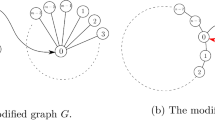Abstract
The distributed bipartite containment control problem of a set of general linear multi-agent systems with structural balanced symbolic graph is studied. The containment control analysis of communication topology under fixed topology and Markov switching topologies are given. Different from the traditional multi-agent containment control, a distributed observer and bipartite containment protocol are designed based on relative neighbour information. Algebraic graph theory and Lyapunov stability theory are applied to make the bipartite containment error and estimation error converge to zero under the action of the containment control protocol, thus making follower agents converge asymptotically to the states of leader agents. Finally, the effectiveness of the theoretical method is verified by simulation examples.
Similar content being viewed by others
References
Y. Jia, “Robust control with decoupling performance for steering and traction of 4WS vehicles under velocity-varying motion,” IEEE Transactions on Control Systems Technology, vol. 8, no. 3, pp. 554–569, May 2000.
Y. Jia, “Alternative proofs for improved LMI representations for the analysis and the design of continuous-time systems with polytopic uncetainty: A predictive approach,” Automatic Control IEEE Transactions, vol. 48, no. 8, pp. 1413–1416, August 2003.
X. Xiao and B. Roh, “Strength enhancement in fused filament fabrication via the isotropy toolpath,” Applied Sciences, vol. 11, no. 13, 6100, July 2021.
X. Xiao and S. Joshi, “Process planning for five-axis support free additive manufacturing,” Additive Manufacturing, vol. 36, 101569, December 2020.
X. Xiao and S. Joshi, “Critical assessment of Shape Retrieval Tools (SRTs),” The International Journal of Advanced Manufacturing Technology, vol. 116, no. 11, pp. 3431–3446, October 2021.
T. Vicsek and A. Czirok, “Novel type of phase transition in a system of self-driven particles,” Physical Review Letters, vol. 48, no. 6, pp. 1226–1229, August 1995.
A. Jadbabaie and L. Jie, “Coordination of groups of mobile autonomous agents using nearest neighbor rules,” IEEE Transactions on Automatic Control, vol. 48, no. 6, pp. 988–1001, June 2003.
G. Ferrari-Trecate and M. Egerstedt, Laplacian Sheep: A Hybrid, Stop-go Policy for Leader-based Containment Control, Springer, Berlin, Heidelberg, pp. 212–2261, January 2006.
C. Altafini, “Consensus problems on networks with antagonistic interactions,” IEEE Transactions on Automatic Control, vol. 58, no. 4, pp. 935–946, April 2013.
H. Su and Z. Michael, “Multi-agent containment control with input saturation on switching topologies,” IET Control Theory & Applications, vol. 9, no. 3, pp. 399–409, February 2015.
G. Ge, “Linear systems with medium-access constraint and markov actuator assignment,” IEEE Transactions on Circuits & Systems, vol. 57, no. 11, pp. 2999–3010, November 2010.
H. Shen, X. Hu, and J. Wang, “Non-fragile H ∞ synchronization for markov jump singularly perturbed coupled neural networks subject to double-layer switching regulation,” IEEE Transactions on Neural Networks and Learning Systems, pp. 1–11, September 2021. DOI: https://doi.org/10.1109/TNNLS.2021.3107607.
J. Wang and H. Xia, “ℋ ∞ synchronization for fuzzy markov jump chaotic systems with piecewise-constant transition probabilities subject to pdt switching rule,” IEEE Transactions on Fuzzy Systems, vol. 29, no. 10, pp. 3082–3092, October 2020.
Fragoso and D. Marcelo, “A unified approach for stochastic and mean square stability of continuous-time linear systems with markovian jumping parameters and additive disturbances,” SIAM Journal on Control & Optimization, vol. 44, no. 4, pp. 1165–1191, January 2005.
C. Deng and C. Wen, “Distributed adaptive tracking control for high-order nonlinear multi-agent systems over event-triggered communication,” IEEE Transactions on Automatic Control, pp. 1–1, March 2022. DOI: https://doi.org/10.1109/TAC.2022.3148384.
D. Zhang and G. Feng, “Physical safety and cyber security analysis of multi-agent systems:a survey of recent advances,” IEEE/CAA Journal of Automatica Sinica, vol. 8, no. 2, pp. 319–333, February 2021.
D. Lei and G. Ge, “Sampled-data leader-following consensus for nonlinear multi-agent systems with Markovian switching topologies and communication delay,” Journal of the Franklin Institute, vol. 352, no. 1, pp. 369–383, January 2015.
Author information
Authors and Affiliations
Corresponding author
Additional information
Xuan Gu is working toward an M.S. degree at Donghua University, Shanghai, China. Her current research interests include multiagent system stability analysis, adaptive control, and containment control.
Wuneng Zhou received his B.S. degree in mathematics from Huazhong Normal University, Hubei, China, in 1982, and a Ph.D. degree in control science and engineering from Zhejiang University, Zhejiang, China, in 2005. He is currently a Professor with Donghua University, Shanghai, China. His current research interests include stability, synchronization, and control for neural networks, multiagent system stability analysis, and formation control.
You Wu is working toward an M.S. degree at Donghua University, Shanghai, China. Her current research interests include fault diagnosis, deep learning, and multiagent system.
Wanpeng Wu is working toward an M.S. degree at Donghua University, Shanghai, China. His current research interests include traffic flow forecasting, deep learning, multiagent, and time series analysis.
Guang Yang is working toward an M.S. degree at Donghua University, Shanghai, China. His current research interests include deep learning, multiagent, traffic flow forecasting, and time series analysis.
Publisher’s Note
Springer Nature remains neutral with regard to jurisdictional claims in published maps and institutional affiliations.
This work is supported by the Natural Science Foundation of Shanghai under grant no. 20ZR1402800.
Rights and permissions
About this article
Cite this article
Gu, X., Zhou, W., Wu, Y. et al. Bipartite Containment Control for Multi-agent Systems Under Fixed and Markov Switching Topologies. Int. J. Control Autom. Syst. 21, 1331–1337 (2023). https://doi.org/10.1007/s12555-022-0027-6
Received:
Revised:
Accepted:
Published:
Issue Date:
DOI: https://doi.org/10.1007/s12555-022-0027-6




